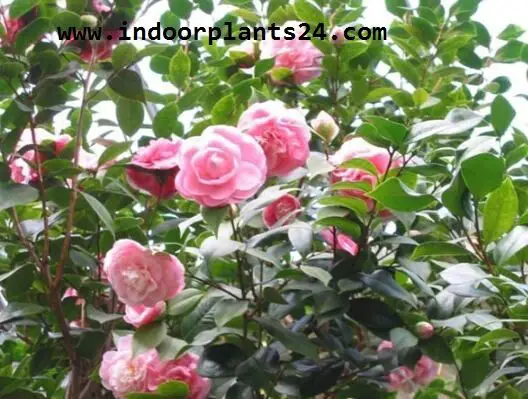10:35 In the home, the beautiful waxy blooms of this winter- and early spring-flowering shrub can be appreciated at close quarters, and they are secure from damaging frosts. 
The flowers may be single, double, or semi-double, carried in clusters or singly, depending on variety.

They may be white, pink, or red, or a combination of either pink or red and white, and may be about 5in/13cm wide. The glossy, dark green leathery leaves are carried on woody branches and tend to curl under slightly from the tips and sides.  Camellias are ideal plants for a cool, airy room. And they do not like the hot, dry conditions of centrally heated houses. They need regular misting and should be set on a tray of gravel to raise the humidity, especially when the buds are forming. Do not move flowering plants; the buds are likely to drop off if you do.
Camellias are ideal plants for a cool, airy room. And they do not like the hot, dry conditions of centrally heated houses. They need regular misting and should be set on a tray of gravel to raise the humidity, especially when the buds are forming. Do not move flowering plants; the buds are likely to drop off if you do.  FACT FILE
FACT FILE
ORIGIN China; Japan; India; Indonesia.
HEIGHT To 10ft/3m or more.
POTTING MIX Equal parts of lime-free soil-based potting mix, peat moss, and coarse leaf mold.  REPOTTING When necessary, move the plant into a pot one size larger after flowering until maximum practical size is reached; thereafter, top-dress at the end of the rest period.
REPOTTING When necessary, move the plant into a pot one size larger after flowering until maximum practical size is reached; thereafter, top-dress at the end of the rest period.  PROPAGATION By semiripe cuttings in early summer; difficult for the amateur.
PROPAGATION By semiripe cuttings in early summer; difficult for the amateur.  KEEPING PLANTS Leave outdoors in a sheltered place in summer; bring under cover in late fall.
KEEPING PLANTS Leave outdoors in a sheltered place in summer; bring under cover in late fall.
Camellia Japonica Theaceae Camellia PLANT CARE
- Bright light but no direct sun.
- Must have cool conditions of 45°-60°F/7°—16°C. Keep the soil evenly moist when the buds are forming. After flowering, allow the surface of the soil to dry out between waterings.
- Mist-spray daily.
- Give a liquid feed every 10 to 14 days during the growing season.
- Stand the plant outside in summer to encourage buds to form.
- Buds will drop if soil dries out in the flowering season.
- Check the undersides of the leaves for scale insects and push off any scales with a fingernail.

- Share
- Share
- Share
- Share
